
Papaver californicum is a species of poppy known by the common names fire poppy and western poppy.
Keckiella lemmonii is a species of flowering plant in the plantain family known by the common name Lemmon's keckiella.
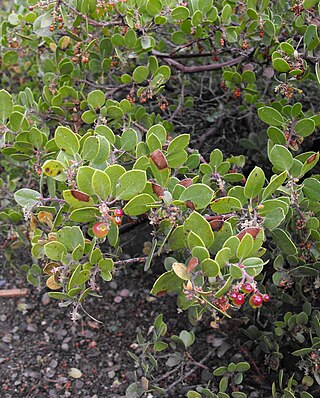
Arctostaphylos rudis, with the common names Shagbark manzanita and Sand mesa manzanita, is a species of manzanita.

Penstemon azureus is a flowering plant species known by the common name azure penstemon.
Penstemon caesius is a species of penstemon known by the common name San Bernardino beardtongue. It is endemic to California, where it is known from the San Bernardino and San Gabriel Mountains, as well as the southern mountains of the Sierra Nevada. It is a member of the flora on rocky slopes and in coniferous forests and alpine habitat in the mountains. It is a perennial herb with erect branches up to about 80 centimeters in maximum height. The lower branches may be woody, the upper hairless and waxy, and the inflorescence glandular. Most of the leaves are basal on the plant, rounded or oval, and up to about 4 centimeters long. The inflorescence produces purple-blue tubular flowers roughly 2 centimeters long. The flower has a glandular outer surface, a coat of hairs inside, and a hairless staminode. The flowers of this penstemon are pollinated by bees of genus Osmia, which feed on their nectar.

Penstemon filiformis is an uncommon species of Penstemon known by the common name threadleaf beardtongue. It is endemic to the Klamath Mountains of northern California, where it grows in forest and woodland, often on serpentine soils. It is a perennial herb growing up to half a meter tall, its stem hairy and woody toward the base. The leaves are very narrow, linear and rolled to threadlike, reaching up to 7 centimeters long, those low on the plant sometimes borne in clusters. The inflorescence produces hairless, tubular or funnel-shaped blue to purple flowers just over a centimeter in length.

Penstemon gracilentus is a species of penstemon known by the common names slender beardtongue and slender penstemon. It is native to the mountains and sagebrush plateau of northeastern California, western Nevada, and southern Oregon, where it grows in forest, woodland, and scrub habitat. It is a perennial herb producing upright branches to about 65 centimeters in maximum height, the stems developing woody bases. The leaves are up to 10 centimeters in length and linear or lance-shaped. The glandular inflorescence produces several tubular purple flowers up to 2 centimeters long. The mouth of each flower may be hairless or coated in long hairs, and the staminode usually has a coat of yellow hairs.

Penstemon heterophyllus is a species of penstemon known by the common names bunchleaf penstemon, foothill penstemon, and foothill beardtongue. It is endemic to California.

Penstemon incertus is a species of penstemon known by the common name Mojave beardtongue. It is endemic to California, where it can be found in many of the southeastern mountain ranges, including the southern reaches of the Sierra Nevada, the Tehachapis, and the mountains of the Mojave Desert region. It is a member of the flora in scrub and woodland, among Joshua Trees and in sandy washes.
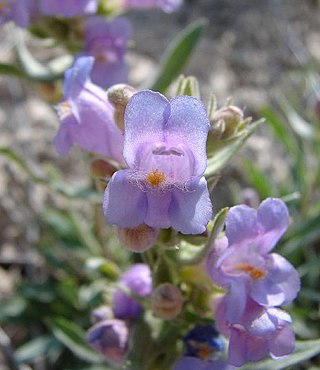
Penstemon janishiae is a species of penstemon known by the common names Antelope Valley beardtongue and Janish's beardtongue. It is native to the northwestern United States in sections of Idaho, Oregon, Nevada and northwestern California, where it is a member of the flora in sagebrush, woodland, and pine forests. It is a perennial herb with several hairy upright stems reaching up to about 25 centimeters tall. The leaves are up to 6 centimeters long, many located around the base of the plant and several pairs along each stem. The inflorescence produces several wide-mouthed tubular flowers 2 to 3 centimeters long. Each hairy, glandular flower is pale purple to pinkish or bluish in color with a dark-lined, pouchlike throat. The mouth of the flower is hairy and the protruding staminode is coated in bright orange or yellow hairs.

Penstemon papillatus is a species of penstemon known by the common name Inyo beardtongue.
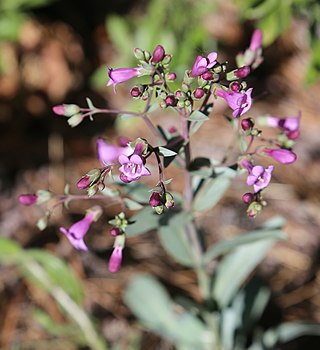
Penstemon patens is a species of penstemon known by the common name Lone Pine beardtongue. It is native to the central Sierra Nevada of California and slopes and plateau to the east, its distribution extending just into Nevada. It grows in forest, woodland, and scrub habitat types. It is a perennial herb producing hairless, waxy stems up to about 40 centimeters tall. The thick, lance-shaped, gray-green, opposite leaves are up to 9 centimeters long and 2 wide. There are usually many leaves clustered around the base of the plant and smaller pairs higher on the stem. The inflorescence bears wide-mouthed tubular flowers up to 2 centimeters long with corollas in shades of lavender to magenta. The flower is mostly hairless except for the staminode which may have a coat of orange or yellowish hairs.
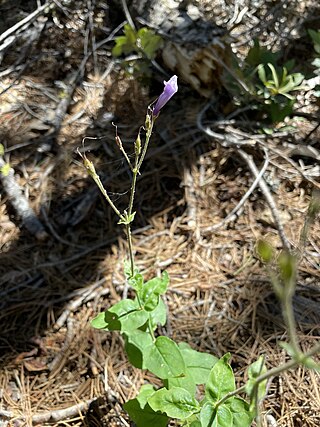
Penstemon personatus is an uncommon species of penstemon known by the common name closethroat beardtongue.
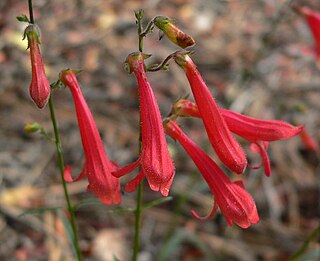
Penstemon rostriflorus is a species of penstemon known by the common names beaked penstemon, Bridge penstemon, or Bridges' penstemon.

Penstemon spectabilis is a species of penstemon known by the common name showy penstemon or showy beardtongue. It is native to southern California and Baja California, where it grows in the chaparral, scrub, and woodlands of the coastal mountain ranges.

Penstemon stephensii is an uncommon species of penstemon known by the common name Stephens' beardtongue, or Stephens' penstemon. It is endemic to California, where it is known only from the mountains of the Mojave Desert region. It grows in scrub, woodland, and sandy clearings, often on limestone substrates. It is an erect shrub which may reach 1.5 meters in height, with many leafy flowering stems. The thin leaves are oval with wide triangular tips and serrated edges. The oppositely arranged pairs fuse about the stem at the bases, sometimes forming a disc. The inflorescence bears glandular, wide-mouthed tubular flowers up to 2 centimeters long in shades of pink or purple. The plant is pollinated by hummingbirds.

Penstemon thurberi is a species of penstemon known by the common names Thurber's beardtongue and Thurber's penstemon. It is native to the southwestern United States and northern Mexico, where it grows in many types of desert and mountain habitat, including sandy flats, chaparral, scrub, and woodlands. It is a shrub growing erect and somewhat rounded in form, reaching around 80 centimeters in maximum height. Many slender stems emerge from its woody base. The leaves are narrow, linear in shape, with edges rolled upward nearly into a tube. The long inflorescence bears funnel-shaped lavender, pink, or pale blue-purple flowers up to 1.5 centimeters in length.

Penstemon utahensis is a species of penstemon known by the common names Utah beardtongue and Utah penstemon. It is native to the southwestern United States, where it grows in scrub, woodland, and canyons. It is a perennial herb growing erect to a maximum height near half a meter. The thick leaves are located around the base of the plant and in opposite pairs along the stem. The upper leaves are lance-shaped and often folded lengthwise, measuring up to 5.5 centimeters long. The showy inflorescence bears many bright red-pink flowers up to 2.5 centimeters in length. They are cylindrical, tubular, or funnel-shaped with wide, lobed mouths, and mostly hairless to slightly hairy and glandular.

Streptanthus callistus is a rare species of flowering plant in the mustard family known by the common name Mount Hamilton jewelflower. It is endemic to Santa Clara County, California, where it is known from only about five occurrences around Mount Hamilton. It grows in chaparral and woodlands and on dry scree. It is an annual herb producing a small stem up to 8 or 9 centimeters tall with a bristly base. The toothed oval leaves are under 2 centimeters long. The inflorescence is a cluster-like raceme of flowers, the top ones sterile. The fertile flowers on the lower raceme have calyces of bristly purple-green sepals under a centimeter long with flaring purple petals at the tip. The sterile flowers at the top of the raceme have narrow, elongated, hairless purple sepals. The fruit is a cylindrical, bristle-studded silique measuring up to 2 or 2.5 centimeters long.

Streptanthus glandulosus is a species of flowering plant in the mustard family known by the common name bristly jewelflower. It is native to California and southwestern Oregon, where it grows in many types of habitat, including grassland, chaparral, and woodlands. Genetic and other analyses indicate that it is a species complex with ten subspecies which evolved as populations were isolated from each other. The complex includes subspecies previously considered separate species, such as the rare Tiburon jewelflower endemic to the San Francisco Bay Area. Plants in the complex are variable. In general they are annual herbs growing 10 centimeters to over a meter in height. They may be hairless hairy to bristly. The ephemeral basal leaves have blades borne on winged petioles. Leaves higher on the stem are linear to lance-shaped and clasp the stem at their bases. Flowers occur at intervals along the upper stem. Each flower has an urn-shaped calyx of sepals one-half to over one centimeter long which can be almost any color from white to yellowish to pink or purple to nearly black. Purple, white, or purple-veined white petals emerge from the tip. The fruit is a straight or curving silique up to 11 centimeters long.



















